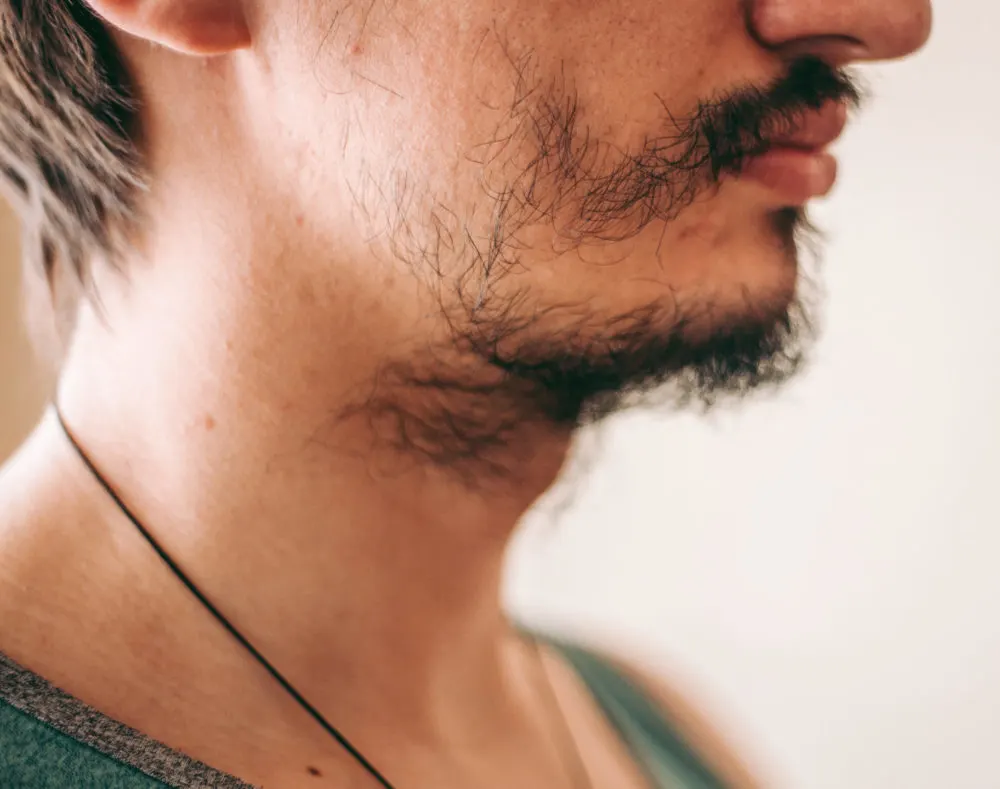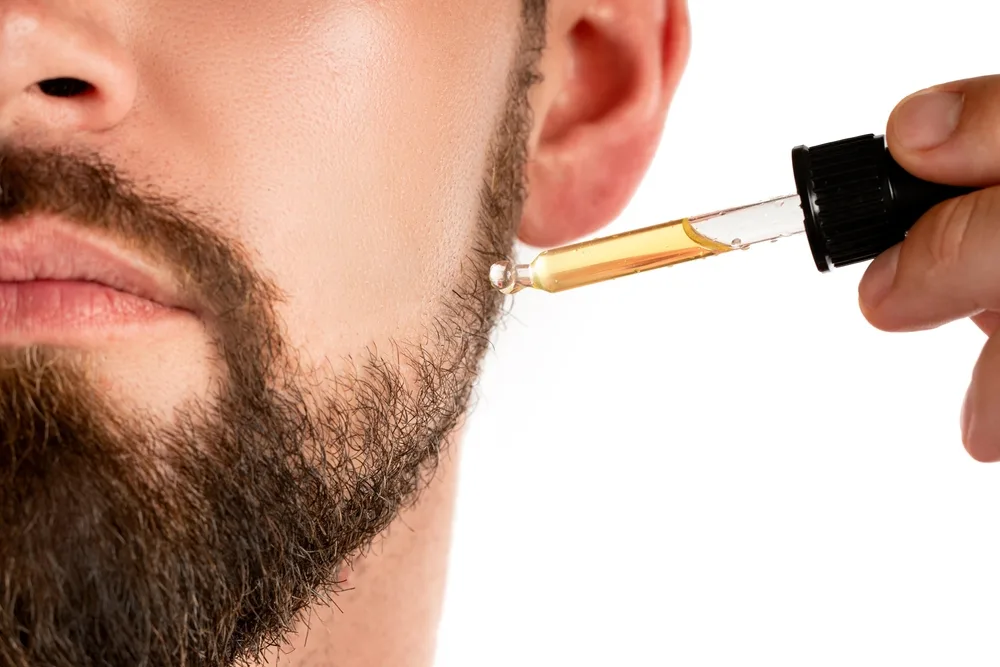Jump to:
How long does it take to grow a beard? It’s one question that every beard enthusiast asks at some point. Growing a full-fledged, luscious beard takes time and patience. Read on and learn about beard growth stages, tips for cultivating a beard, and more.
How Long Does It Take to Grow a Beard?
It takes 2-4 months to grow a full-fledged beard. If you’re starting over, you will realize that your facial hair grows between 0.3 mm and 0.5 mm every day.
That means you’ll have a beard growing between 1/3 and 1/2 an inch monthly. As a beard enthusiast, you may wish to have a beard that grows fast and healthy. Unfortunately, some men have difficulty growing a full beard, while others won’t.
So, before wondering how long it will take to fill in a full beard, consider the type of beardsman you are. Many factors come into play when determining how long it takes to grow a full beard.
And by a full beard, we mean facial hair that covers your chin, jaw, cheeks, and lip. A full beard also includes the beard growing on the neck area.
However, you should keep this section trimmed, lest you end up with a “neckbeard effect.” So, what are you aiming for when growing a beard? Are you interested in a short, Duck Dynasty, or a ZZ top type of beard?
Before answering, here are some quick beard facts to consider when growing a beard:
- When left alone, a beard can grow up to three feet in length
- A beard reaches its longest point at six years and stops to grow
- A beard’s growth rate in most men will be high at the age of 25-35, although it will always vary from man to man
- Many factors such as genetics, age, and race will determine how fast your beard grows
- Testosterone is the major determining factor in beard growth
Does it feel like all odds are against you, and you can’t grow a luscious, healthy beard that everyone around you envies? Thankfully, we’re offering reliable ways of promoting fast and thick facial hair. But first, let’s first look into the various beard growth stages.
Beard Growth Stages
Beard growth occurs in five stages. Understanding what to expect from each stage will help you plan how to handle your facial hair as you wait for the next step.
If you’ve stopped shaving and want to grow a beard, expect your facial hair to grow in the following stages:
The Stubbly Stage
Stubble is the initial beard growth stage after shaving and occurs in the first week. During the stubbly stage, you shift from having a clean shave to the 5 o’clock shadow. The 5 o’clock shadow is the short, sharp facial hair growing around your sideburns, jawline, and lip.
During this stage, the new growing beard is itchy. Though temporarily, you will also notice some ingrown hair that might irritate your skin. The best way to minimize the irritation is by cleaning the area and using moisturizer or beard oil to hydrate and soothe the skin.
At the end of the stubbly stage, you should be able to tell how fast your facial hair will grow. Areas with higher follicle density are easy to identify, allowing you to know where you can grow a substantial beard.
The Patchy Stage
This is the second stage of beard growth, occurring between week two and week three. In the patchy stage, beard growth is better in some parts than others, creating patchy sections.
Remember, you’re growing new facial hair to cover new ground, and it’s common to see an uneven beard growth rate. The patchy parts are common around the jawline and chin.
Having some parts with longer facial hair than others can be frustrating, and you might get tempted to shave your beard off. But stick with it because you’re about to experience some positive outcomes in two weeks.
By the end of week 3, your hair follicles will start to catch up with each other, and the patchy areas will begin to fill in. Continue using beard oil and moisturizer to condition your beard.
The Short Beard Stage
The third stage of beard growth occurs between week four and week five. During the short beard stage, your facial hair becomes thicker as the patchy areas fill in. Since facial hair growth rate varies from person to person, you’ll know whether you’re good with a full beard or goatee.
The Growth and Grooming Stage
The growth and grooming stage starts from week six to week seven. During this stage, you will have a full beard that needs regular styling and grooming. Failure to pay attention to your facial hair during stage four results in a curly and dry beard.
Some facial hairs might be longer than others. To keep your beard healthy and luscious, wash it at least 2-3 times a week. Beard shampoo will be handy when cleaning facial hair and the skin underneath.
To avoid a curly beard, use a beard brush to get rid of those unruly facial hairs. Trim those facial hairs longer than the rest using scissors or a beard trimmer. Lastly, use beard oil to keep your beard soft, moisturized, and smelling nice.
The Full Beard Stage
The full beard stage (accomplishment stage) is the last stage of beard growth. You’re now in the second month of beard growth and enjoying a full and luscious beard.
If you’re taking good care of your facial hair, you can expect to see everyone around in awe, stealing glances at your glorious beard. Since you’re seeing slower beard growth, committing to maintaining your full beard is the best thing to do.
Comb, trim, clean and moisturize your facial hair more often to have a healthy, luscious beard. Now that you know the five stages of beard growth, are there factors affecting your beard growth?
Factors Affecting Beard Growth

Gennadiy Naumov/Shutterstock
Beard growth is a journey, and numerous factors influence how thick your facial hair grows. Some are outside your control, while you can work on others to develop a full beard.
Genetics
Genetics plays a significant role in influencing your beard growth rate. According to scientists, genetics determine about 80% of male baldness. Genetics determines whether you can grow a full beard or not.
If you want to understand how genetics influence your beard growth, observe your older male relatives. If they have a full-fledged beard, you’re also likely to grow a full beard and vice versa.
Age
You’ve probably seen young men at 18 growing a full beard and a 30-year-old guy who still struggles to grow full-fledged facial hair. The thing is, age plays a crucial role in beard growth.
Most men will experience a full beard between the age of 25 to 40. If you’re under 25 years and still have a bald face, you probably need to wait a few years to grow a full beard.
What if you’re over 30 years and your facial hair has been slow-growing? Don’t worry. Good days are ahead of you. It might take longer, but you’ll certainly cultivate a full beard.
Ethnicity
The hair growth or hirsuteness in men of different ethnic groups tends to vary. Men of Middle Eastern and Mediterranean descent have an easier time growing facial hair than men of African and Asian descent. Most African men may have difficulty developing a thick beard, while Chinese men grow less facial hair.
Testosterone Levels
Testosterone is the primary ingredient for beard growth. Men with high testosterone levels grow a full beard, while those with low testosterone levels tend to struggle growing one. As you age, your testosterone levels change.
By age 40, your testosterone levels decrease by almost 1% yearly. If you wish to combat low testosterone levels, seek the help of your doctor. He may recommend supplements or testosterone therapy.
Read Next: How to Grow a Beard
Tips for Growing a Full Beard

Blackday/Shutterstock
Do you want to grow a full beard and enjoy the envy of those around you? Below are a few tips you may try to increase your beard growth rate.
Balanced Diet
Growing healthy hair requires eating a balanced diet. And if you’re aiming for a healthy beard, your everyday meals should have all the nutrients your skin and facial hair needs.
Include fruits, lean proteins, vegetables, and whole grains in your meals while avoiding added sugars and processed food. Eat plenty of vitamins A, C, and B.
The best source of vitamin B is biotin. Many foods such as beef liver, sunflower seeds, sweet potato, eggs, and pork contain biotin and will help you grow a healthy beard.
Exercise
Exercising is an excellent way of stimulating blood circulation and boosting testosterone levels. Blood circulation plays a huge role in hair growth while increasing testosterone levels help you to grow more facial hair.
Reduce Stress
Stress is one of the beard’s worst enemies. Too much stress can deteriorate your health and affect hair growth, leading to facial hair loss. While stress is inevitable in life, there are numerous ways of reducing it.
For example, use a meditation or relaxation app to help you escape stressful moments. Eat a healthy diet and exercise regularly. Find new hobbies and communicate with family or friends about what you’re going through.
Get Enough Sleep
Set a bedtime routine and ensure you sleep between 6-8 hours every night. Sleep is also a great way of reducing stress. When you sleep enough, your body gets plenty of time to regenerate cells that are essential for beard growth. Your body releases testosterone during your deepest sleep, which helps you grow a full beard.
Read Next: Does Beard Oil Work for Beard Growth?
Frequently Asked Questions

Just Dance/Shutterstock
Can you grow a beard quicker?
You can grow a beard faster by caring for your general health and the skin around your face. Eat a healthy diet, and keep the skin underneath your facial hair clean and moisturized.
Why can’t some guys grow beards?
Some people won’t grow beards because of genetic factors. If your father or male relatives don’t have a full beard, you will likely not grow one.
Do beard oils work?
There’s no scientific proof that beard oils stimulate beard growth. However, they moisturize and soften your facial hair and skin beneath.
How long does a beard grow in a week?
Most men will grow around 3 mm of facial hair in a week. However, the growth rate varies from person to person.
At what age is a beard fully developed?
Some men will have a fully developed beard at around 15 years. Others start growing facial hair at about 18 years, while others can wait from 25 to 40 years.
So, How Long Does a Beard Take to Grow?
Most men grow a full beard after 2-4 months. After a clean shave, your beard grows between 0.3 mm to 0.5 mm daily (around 3 mm weekly). That equates to between 1/3 and 1/2 an inch every month.
